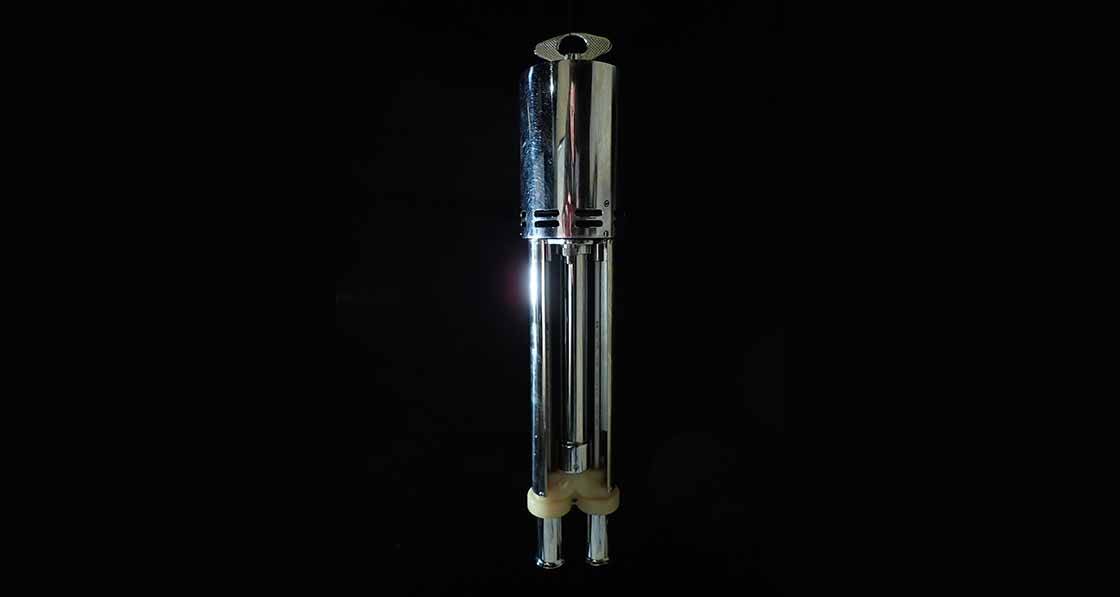
- Blogs
- Posted
Measuring humidity, the old school way
A chance purchase on eBay leads buildings physics expert Toby Cambray to admire the aesthetics and mechanics of old scientific instruments.
This article was originally published in issue 37 of Passive House Plus magazine. Want immediate access to all back issues and exclusive extra content? Click here to subscribe for as little as €10, or click here to receive the next issue free of charge
A few months back, I was browsing eBay in an idle moment, and came across something so wonderful I could not resist buying it immediately. It helped that it wasn’t very expensive. It’s a hefty chrome plated scientific instrument with an aesthetic somewhere between art deco and steampunk, about 400 mm long.
The object in question is pictured here, and I popped a photo on Twitter for a guessing game, eventually won by passive house consultant Nick Grant.
What on earth is this infernal device that so beguiled me? It has a key at one end for winding a clockwork (none of that new-fangled electricity) mechanism that whirrs and ticks in the most delightful way, driving a small fan within the casing. The fan draws air down a tube connected to a pair of tiny trumpet #ares; in the middle of each there nestles the bulb of a simple mercury thermometer. What is the purpose of such an instrument?
Nowadays, if we want to measure humidity there are a plethora of inexpensive electronic sensors, most of which work by measuring the change in capacitance of slivers of special materials as they take up and release moisture from the air (yes, they’re hygroscopic like Jaffa Cakes). But go back several decades and such technology was unavailable, or at least unaffordable or imprecise – not that one can rely too heavily on relative humidity measurements, even today. So, in the absence of a handy miniaturised sensor, how could you measure humidity?
One answer is stylishly demonstrated by my mysterious device. You may have come across the term ‘dry bulb temperature’ as a measure of air temperature. In isolation this might seem slightly odd to a twenty-first century reader, unfamiliar with the low-tech measurement of humidity. If it occurs to you that the term dry bulb implies a similar metric called wet bulb, you’d be right, and this explains the pair of thermometers. To operate my device, it requires the addition of a tiny sock over one of the thermometers, which is then wetted.
As seasoned hillwalkers know, wet socks are bad news. Your feet get cold to an extent out of proportion with the temperature of the rain or puddles. This is due to the loss of latent heat – the water evaporates away from your feet but takes a certain amount of heat in doing so. This effect is turned to advantage in the hygrometer: the wet sock reduces the temperature of the wet-bulb thermometer and by comparing it with the dry bulb temperature, the humidity can be inferred.
This is because the reduction in temperature caused by the evaporation depends on humidity. If the humidity is 100 per cent, no evaporation can take place because the air can’t hold any more moisture, but at 0 per cent humidity, the evaporation is maximised.
The rate of evaporation and subsequent reduction in bulb temperature is a bit complex and depends on a number of things including air velocity, so each make and model of these old-fashioned hygrometers comes with its own empirical look-up tables to convert the temperature readings to humidity. If you’re familiar with the idea of wet-bulb hygrometers, you might be better acquainted with the style that looks like an old-fashioned football rattle, and is waved around the same way. The advantage of the fan is to ensure a more consistent air velocity and therefore a more repeatable measurement, as well as looking like a space pirate’s double-barrelled blunderbuss.
To operate my device, it requires the addition of a tiny sock over one of the thermometers, which is then wetted.
While modern devices might be a fraction of the price, more reliable, convenient and accurate, and have capabilities far outstripping old technology, there’s something charming about vintage scientific equipment, all mahogany and little brass plaques.
My dad, an ex-science teacher, has a study filled with obsolete demonstration kit, salvaged from various school clear-outs, and it’s this element of education that also makes these old things interesting – you can figure out how they work, and learn a great deal along the way.



